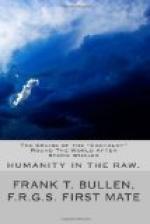The contrast between the two animals is most marked, so much so, in fact, that one would hardly credit them with belonging to the same order. Popular ideas of the whale are almost invariably taken from the mysticetus, so that the average individual generally defines a whale as a big fish which spouts water out of the top of his head, and cannot swallow a herring. Indeed, so lately as last year a popular M.P., writing to one of the religious papers, allowed himself to say that “science will not hear of a whale with a gullet capable of admitting anything larger than a man’s fist”—a piece of crass ignorance, which is also perpetrated in the appendix to a very widely-distributed edition of the Authorized Version of the Bible. This opinion, strangely enough, is almost universally held, although I trust that the admirable models now being shown in our splendid Natural History Museum at South Kensington will do much to remove it. Not so many people, perhaps, believe that a whale is a fish, instead of a mammal, but few indeed are the individuals who do not still think that a cetacean possesses a sort of natural fountain on the top of its head, whence, for some recondite reason, it ejects at regular intervals streams of water into the air.
But a whale can no more force water through its spiracle or blow-hole than you or I through our nostrils. It inhales, when at the surface, atmospheric air, and exhales breath like ours, which, coming warm into a cooler medium, becomes visible, as does our breath on a frosty morning.
Now, the mysticetus carries his nostrils on the summit of his head, or crown, the orifice being closed by a beautifully arranged valve when the animal is beneath the water. Consequently, upon coming to the surface to breathe, he sends up a jet of visible breath into the air some ten or twelve feet. The cachalot, on the other hand, has the orifice at the point of his square snout, the internal channel running in a slightly diagonal direction downwards, and back through the skull to the lungs. So when he spouts, the breath is projected forward diagonally, and, from some peculiarity which I do not pretend to explain, expends itself in a short, bushy tuft of vapour, very distinct from the tall vertical spout of the bowhead or right whale.
There was little or no wind when we sighted the individual I am now speaking of, so we did not attempt to set sail, but pulled straight for him “head and head.” Strange as it may appear, the mysticetus’ best point of view is right behind, or “in his wake,” as we say; it is therefore part of the code to approach him from right ahead, in which direction he cannot see at all. Some time before we reached him he became aware of our presence, showing by his uneasy actions that he had his doubts about his personal security. But before he had made up his mind what to do we were upon him, with our harpoons buried in his back. The difference in his behaviour




